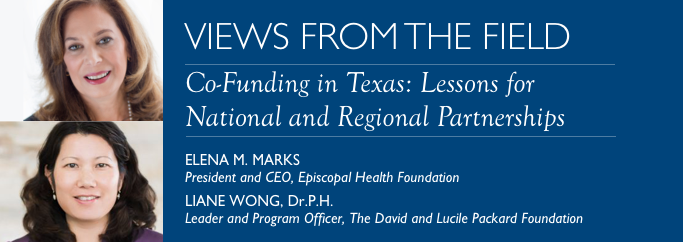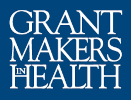
When grantmakers partner on issues of mutual concern, they can leverage their funds in ways that make significant progress. We are pleased to share the perspectives of a national and regional funder on their evolving partnership at the emerging intersection between health and early childhood. GIH’s Ann McMillan sat down with Elena Marks, CEO of Episcopal Health Foundation (EHF) and Liane Wong, Leader and Program Officer at the David and Lucile Packard Foundation to learn more about their approach to co-funding and learning together across child and family issues as well as early signs of impact in their shared work across policy/advocacy, capacity building and technical assistance to organizations, and the families they serve in Texas.
GIH: When did you first learn about each other’s missions and work intersecting children’s health and early childhood development?
LW: For the past several years, the Packard Foundation has supported GIH funder networks that focus on children’s health. At the GIH Annual Conference on Health Philanthropy in Austin in March 2015, we invited a group of Texas funders to join the network breakfast session conversation along with other colleagues from around the country. Serendipitously Elena as the new CEO of Episcopal Health sat at my table. And the rest is history.
EM: The 2015 GIH conference was one of the first philanthropy conferences I had attended, having begun as the founding CEO of a new foundation the previous year. I signed up to attend the breakfast because the agenda included a presentation by the Center for Public Policy Priorities (CPPP), a top notch Texas-based policy shop known for the breadth, depth, and accuracy of its work in access to health services, a priority for Episcopal Health Foundation. When I learned that CPPP’s work in children’s coverage and access to quality health care was funded by the Packard Foundation, I talked with Liane. We followed up after the conference and, when Liane told me that the Packard Foundation planned to offer another round of funding across several states, I jumped at the opportunity to co-fund in our region.
GIH: How has deeper collaboration helped further your goals and your impact. What has been accomplished?
LW: In 2014, the Packard Foundation broadened its goals in children’s coverage and access to include children’s healthy development. This new strand of work built from our access to care focus and was designed as a two-year exploration with a modest initial investment. We had just enough funding for five states and at the time of our recommendation also wanted to include Texas. Because of the state’s size, we recognized the importance of partnering with local and regional funders the Packard Foundation could bring its multistate health policy expertise, national leadership, and technical assistance infrastructure to the partnership and Episcopal Health could bring their regional leadership, deep knowledge, and relationships, to ensure our collective resources were smartly deployed.
EM: For EHF, this partnership presented an opportunity to work with a national funder with deep experience in child health. Because 2015 was our first year of grantmaking, we were in deep learning mode and not yet able to develop the kind of program the Packard Foundation had conceived. Also, we wanted Texas organizations to be able to participate in this work and understood that their being part of a six-state cohort with national technical assistance would enhance their experience well beyond the funding itself.
GIH: What advice do you have for other funders seeking to bridge national and state level approaches, particularly in the area of advocacy and policy change?
LW: Sometimes we have the tendency to be more tentative at the start of a new partnership. But when it comes to breaking through in policy and systems change for children’s health and well-being, and even more so in large, politically complex states, my advice is to think creatively and boldly about synergies from the start. Some of those early ideas or far-reaching goals may get dialed back, but I think starting with a bold north star is more likely to open the door for more opportunities down the road, while ensuring open communication among our teams and agreeing on shared outcomes with our grantees. It is often harder to ramp up from incremental unless you have really outsize success. Then have the discussions early about grantee fit for both organizations. Keep each other apprised on a quarterly or semi-annual basis. Be up front with challenges anticipated or unanticipated, and create a safe space to make course corrections if needed together.
EM: With the right partner, it is a win-win-win opportunity. As a regional funder, we were able to leverage our grant funds with a larger national funder. The grantees had the opportunity to join a national network, learn from other states in an emerging children’s health area, and obtain technical assistance not available to them as stand-alone grantees. In the area of policy, the particular focus of our collaboration (states’ approaches to early childhood intervention), working across jurisdictions leads to bigger, broader thinking.
GIH: Are there specific ways that national funders can partner more productively with state or regional funders that are sustainable, including in the area of capacity building?
LW: At the Packard Foundation, we value authentic partnership and the patience to invest with a five to ten-year time horizon when aiming for real policy and systems change. This is especially true in large, complex states where there is greater need. It is also important to plan for a longer timeframe if you are focused on capacity building that is sustainable and at some point may actually align with other sectors to impact child and family health. If results fail to materialize in the first two years, work through the urge to pull out or become too tentative, as ramp up and capacity building takes time and some experimentation. If results are slower to materialize, make sure you have feedback loop with your local partners and an evaluation in place to understand what is happening at the state and local levels.
EM: For EHF, as a newer foundation, we have sought out opportunities to partner with national funders and have found several who are willing to do so. We can accelerate progress by partnering with others who are further on the learning curve. Our hope is that as we develop our own programs, the relationships we have built will encourage these national funders to co-fund within our region, or to fund similar programs elsewhere for a broader impact.
GIH: Any unexpected learning or insights from your collaboration that you would like to share with the field?
LW: I have always been deeply curious and appreciative of the organizations and funding community working in and across health, education, and economic opportunity in Texas. The Texas funding community is diverse and growing, and I would offer that our experience developing partnerships with EHF and others have yielded important coverage results for children and families. We hope similar results will come in children and families’ access to quality care over the next decade. Together we have seeded fertile ground and a field of opportunity that we encourage other national funders to actively explore and consider growing.
EM: A disproportionately small amount of national funding reaches Texas. It is a complicated state, sometimes officially hostile to progress in areas about which we care deeply, including health equity, and some funders write us off. Some Texas organizations do not seek funding from national funders, in some cases because they do not realize the funding is available. Through our partnership with the Packard Foundation, we have come to view ourselves as a bridge: we can help national funders “land” well in Texas and we can help Texas organizations gain access to the knowledge, technical assistance, and funding available nationally.

